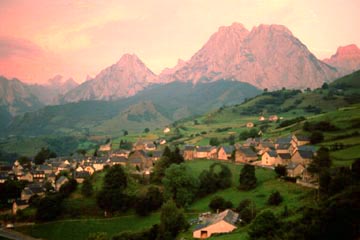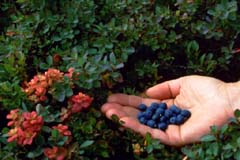In detail ...
Today an enforced lie-in; the village shop would not open until 9:30am. That gave us time to eat an ample breakfast (rice from the free-food shelf!) and post nearly 1kg of surplus posessions after La Poste opened. Then we stocked up with pasta, mackerel, apples, tomatoes, prunes and bread. We came away muttering about the range available, our choices, and the lack of things which we really wanted. Under grey skies, we followed the road out of the village, noseying at a campsite where we might have stayed, and following GR10 markers. Once off the tarmac, a devious but pleasant level traverse took us through the forest and around the north end of a hill to arrive near Lhers. From there a 600m climb led up steeply
en lacets to disappear into the forest.
The Capercaillie
French: 'Grand Tetra'. This is the biggest game bird in Europe, frequenting the fir trees of the wooded mountain stage. A secretive and elusive bird, you must be quick to recognise it when surprised from forest cover, but its heavy escape flight is a leading clue to its identity. The cock sports a red 'eyebrow' and its plumage is brown and dark iridescent green; this is shown off to advantage in the mating season when (like the blackcock) it gathers in leks to compete for female attention, parading with fanned tail. The hen wears humbler colors; mottled buff-blacks.
The route-finding should have been easy as we followed the GR10, but despite our casting around, we got lost on steep forest slopes for a while. The noise of a big logging truck guided us out and for a while we were glad to be on a
piste but that in turn became tedious and we were happy to follow
balisage back into the woods. Somewhere on those shadowy fringes, a very large bird broke cover and beat its way through the twiggy brash; a rare glimpse of the Capercaillie.
The Col de Barrancq (1601m) was finally gained and a well defined shoulder led us out of the trees, where splendid views right back to Lescun held us breathless;
Voici!
had we really just come from so far? The autumnal hints were notable today, with scarlet fly-caps and berries; rowans, dwarf rose-hips and bilberries. We stopped to glean a few of the latter but the darkening clouds threatened rain so we resumed the climb. The barometer had been falling over the last few days and we expected poorer weather.
On the way now, I noticed a definite change in the rock type. The sharp grey limestone had given way substantially to a friable purple shale, but the pointy limestone peak of Pene d'Udapet rode the shale as a limpet on a boulder. Pic Labigouer (2175m) itself comprised wholely of purple rock; by the time we got there the drizzle had commenced, so otherwise good views were hazy. Another highest point attained; this one didn't feel so lofty, being broad and grassy, like a Lake District fell. At Col de Souperet (1920m) beyond, we took advantage of a lull in the drizzle and settled down to a snack of bread and prunes; the dense but soft bread was excellent, and we still remember that Lescun loaf as the best found anywhere during the trek.
We were joined by a shepherd with his flock and dogs; a real man of the mountains. He chatted to us about the route ahead, the refuge at Arlet, and explained his simple life-style based at a
cabane not far below. He also told us why he had two breeds of dog; the familiar black and white sheepdog for rounding up the flocks, and the Great Pyrenean mountain dog which protects instinctively. These shaggy white dogs are known locally as
patou and are descended from Tibetan stock; they are revered for docility, and loyalty to their owners. 'From what', we asked naively, 'did the sheep need protecting?'
'Bears, and the occasional wolf which strays in from the Picos d'Europa in Spain'.
That wasn't the most comfortable thing to hear and I raised my eyes to scan for dark shadows lurking in the distant forest verge. Of course I already knew there would, or should at least be bears here. The shepherd then questioned us; 'Where will you go to next?'
'We are going via Col de Somport to arrive at Ref Pombie.
'Then you will pass by Pic de Midi d'Ossau'. He 'spat' out the consonants of this name with a certain relish and pointed eastwards, but cloud obscured the Pic. Our shepherd friend may only have used this formal title for the mountain in conversation with strangers, for it is known familiarly among the locals as Jean Pierre. We left him, thinking how comforting it would be to have a cuddly
patou guard us from
bears and
wolves ...
The drizzle threatened once more and we resumed course, now ill-defined. A series of sheep trods skirting out Table de Souperet, where the drizzle, now rain began to soak and chill us. This was the first persistent rain of the trek which we were obliged to walk in, and we were not really ready for it; up near the 2000m level, warmer clothes would be necessary. It seemed remote up in those cold mists, but that feeling vanished at Col de Saoubouthou (1949m) where we joined a well worn trail and a throng of French school-kids, all on their way to Ref Arlet. Some of the stragglers were grateful for our assistance as they stumbled off-route in the thickening cloud.
The last zig-zags brought us and the kids out to the shores of the little lake, almost choppy with the brisk wind; there we left the kids to crowd the refuge, while we hardy ones fought wind and rain to establish a pitch and install ourselves before getting too wet.
Karen_comments
The battle continued in preparing a meal; how to shelter the stove sufficently and keep the pan from boiling over, while remaining dry oneself?! Having beaten the elements, satisfaction then came as we settled to eat. The refuge we noted, looked secure and inviting with its steep apex roof and solar panels; but we really had all we needed here, and though the tent was probably even more cramped than the refuge with all its occupants, the space we had here was all just our own.


